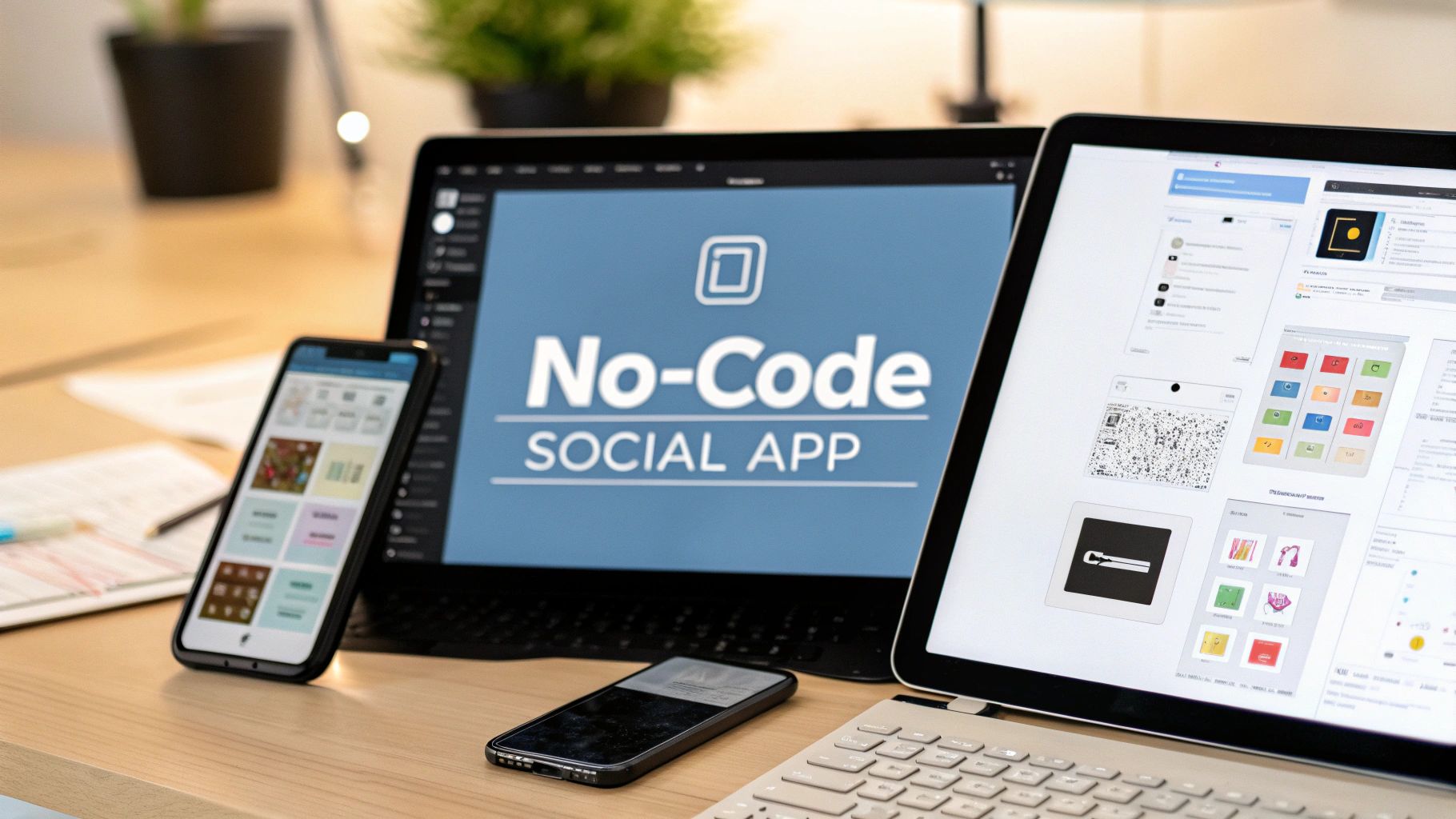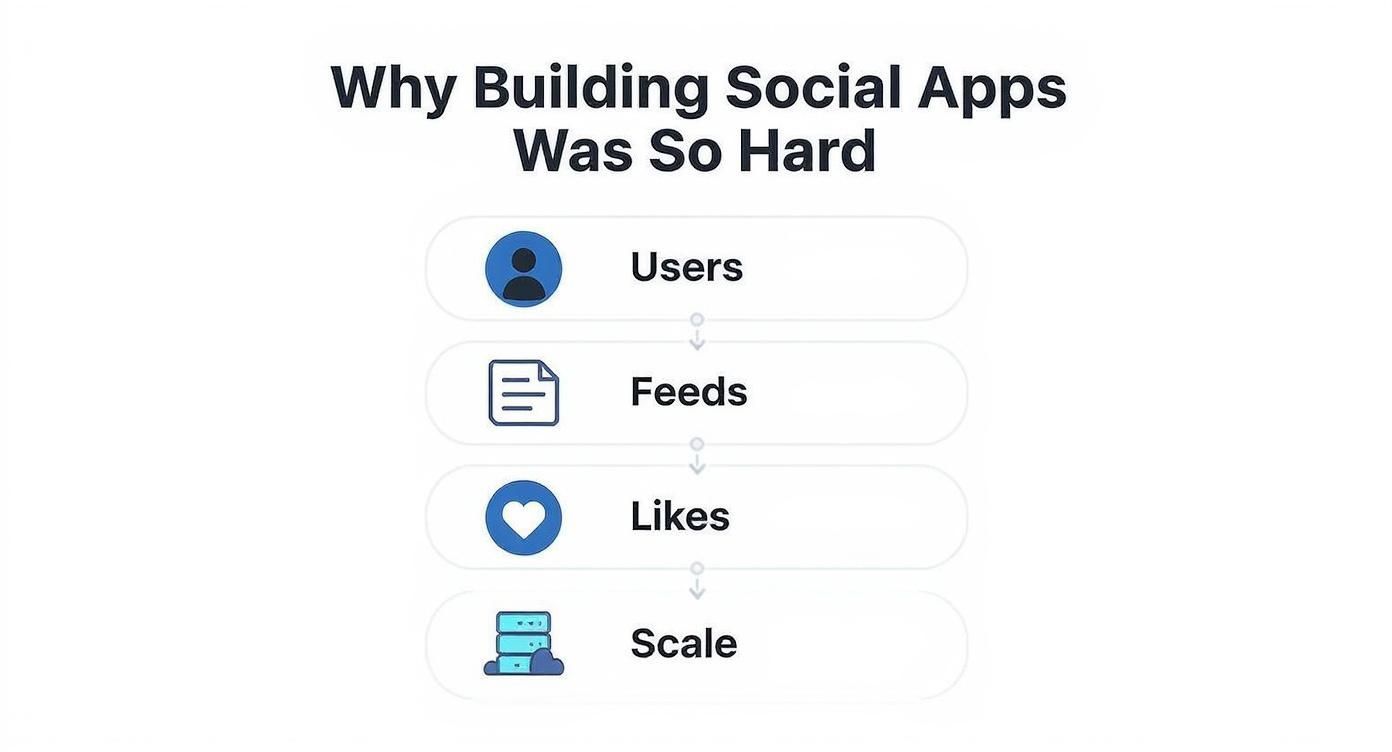How an AI App Generator Can Create Your Social Media App (Without Code)
Learn how to create social media app with AI tools - no-code guide from idea to prototype.
By Sanket Sahu
5th Nov 2025

Every year, thousands of founders dream up the next Instagram or Reddit—but most never launch. Historically, the blockers have been immense: backend complexity, UI design, and long, expensive development cycles that drain resources before an idea ever meets a real user.
But that's the old way. We’re in a new era where AI-native builders let you go from a simple text prompt to a real, testable social media app prototype in minutes, not months. This guide shows you exactly how it’s done.
The Traditional Challenge of Building Social Apps

Before diving into the AI workflow, it’s important to understand why building a social app has always been so hard. We're not just talking about a few screens; we're talking about a living ecosystem with complex, interconnected features.
Here are the classic hurdles that used to require a full development team:
- Authentication: Securely managing user sign-ups, logins, and profiles is a major undertaking.
- Feeds and User-Generated Content: Building a dynamic feed that handles thousands of simultaneous photo, video, and text uploads requires a powerful database and content delivery network (CDN).
- Interactions: Features like likes, comments, and follows need to feel instant, which demands real-time database infrastructure.
- Real-Time Data and Scalability: An app that works for 100 users will crash with 10,000 without complex server architecture designed for scale.
An honest note: AI can’t replace all backend logic—yet. An AI app generator is brilliant at scaffolding the entire front-end and UX flow. It builds what your user sees and touches. You'll still need to connect this front-end to a backend service like Firebase or Supabase to handle live data, but the heaviest lift—the user interface—is now automated.
The New AI Workflow: From Prompt to Social App
This is where the game changes for solo founders and early-stage startups. AI app generators like RapidNative don't rely on rigid, drag-and-drop templates. Instead, they interpret your instructions in natural language and generate real, high-quality mobile code from scratch.
The workflow is simple, powerful, and fast:
- Describe your app in a simple text prompt.
- The AI generates the screens and navigation logic automatically.
- You preview and edit the design in a visual canvas.
- You export the app as production-ready React Native code.
This process empowers you to focus on the what and why of your app, not the how.
Step-by-Step Tutorial: Building a Social Media App
This is the core of the process. Let's walk through building a basic social app, step by step, using this new AI-native workflow.
Step 1: Write the App Prompt
Clarity is key. Your prompt should define the core user journey and essential features. Avoid vague language and be specific about what users can do.
Example Prompt:
“Create a social app where users can post photos, like posts, and follow each other. Include a home feed, profile page, and upload feature.”
This single paragraph contains enough information for the AI to generate the foundational structure of your app.
Step 2: AI Generates Screens
After you submit your prompt, the AI gets to work. It doesn't just create static images; it builds functional screens with interactive components and connects them with logical navigation.
You can expect to see these screens generated instantly:
- Login & Sign-Up: The entry point for user authentication.
- Home Feed: A scrollable view with post cards, like buttons, and comment icons.
- Post Composer: An interface for uploading a photo and adding a caption.
- Profile Page: A screen to display a user's bio, follower counts, and photo grid.
Step 3: Refine and Customize
The initial output is your starting point. Now, you can refine the app by giving the AI follow-up instructions in plain English. Think of it as a conversation with an incredibly fast developer.
Example Refinements:
- “Change the primary color to #5A48E3.”
- “Add a button to open the camera and upload a photo.”
- “On the profile page, add a settings icon in the top right corner.”
Step 4: Preview and Test on Device
This is where your idea feels real. Use a live preview tool (like Expo Go) to run the app directly on your smartphone. This isn't a simulation—it's your actual app running on a real device.
Founder Tip: Make 5 friends test it and collect UX feedback. Watch where they get stuck or confused. Their first impressions are your roadmap for what to improve next.
Step 5: Export or Extend Code
Once you’re happy with the user flow, you can export the entire project. The output is clean, organized React Native code—the industry standard for cross-platform mobile development. A developer can take this code, connect it to a backend service like Firebase or Supabase, and start implementing live data features immediately.
Visual Example: The Core Flow
To simplify, the entire AI-native workflow can be visualized as a direct path from your idea to a tangible product. This diagram illustrates how a single prompt transforms into a fully interactive user experience.

Prompt → Generated Screens → Feed View → User Profile → Export Code
Comparison: AI-Native vs. Template-Based Builders
Not all "no-code" tools are created equal. It's crucial to understand the difference between older template-based builders and modern AI-native generators.
| Feature | Template Builder (e.g. Adalo, Glide) | AI-Native (e.g. RapidNative) |
|---|---|---|
| Custom Features | Limited to pre-built components. | Infinite; defined by your prompts. |
| Output | Often a web-based app in a wrapper. | Real, mobile-native React Native code. |
| Scalability | Poor; often requires a complete rebuild. | Developer-ready and built to scale. |
| Speed | Fast for simple, standard apps. | Fast, with unlimited flexibility. |
| Learning Curve | Easy (drag-and-drop). | Slightly higher (requires clear prompting), but infinitely more powerful. |
For a serious social app with growth potential, the AI-native path provides a professional, scalable foundation that won't hold you back.
Optional Add-On Features to Try
Once you have the basics down, encourage your creativity! Experiment with prompts to add more advanced features and see how the AI responds. This is a fast, risk-free way to explore new ideas for your app.
Try prompts like:
- “Add a notifications screen that shows new likes and follows.”
- “Allow users to tag photos with their location.”
- “Add a dark mode toggle in the settings.”
This iterative process shows the true power of an AI app creator—it enables you to build, test, and evolve your product at the speed of thought.
Common Mistakes When Building with AI

An AI builder is a powerful tool, but it's not a mind reader. To get the best results, avoid these common pitfalls.
- Writing vague prompts: A prompt like “build a cool app” is useless. Be specific about features and user actions.
- Fix: Define the core journey: "Create an app for users to post photos, like posts, and follow each other."
- Ignoring structure: Jumping in without a basic user flow in mind leads to a disjointed app.
- Fix: Sketch a simple flow on paper first (e.g., Sign Up → See Feed → View Profile).
- Overcomplicating the MVP: Trying to build every feature at once results in a bloated, confusing prototype.
- Fix: Focus on the single most important user action for your first version.
- Not testing on real devices early: A design that looks good on your monitor can feel terrible on a phone.
- Fix: Use the live preview feature constantly and get it into friends' hands as early as possible.
The Future of AI-Generated Social Apps
We're just scratching the surface of what's possible. The future of building social apps isn't just about speed; it's about intelligent experimentation. AI will soon enable founders to generate multiple versions of a user flow, A/B test them with real users, and gather data on which design performs best—all before writing a single line of custom code.
AI won’t replace your originality or your unique vision. It’s here to amplify it by removing the technical barriers that once stood in the way. It empowers you to iterate faster, test bolder ideas, and focus on building a community, not just an app.
The next viral app might be built by one person and an AI-native stack.
Ready to see how quickly your idea can become a tangible app? With an AI app creator like RapidNative, you can go from a simple prompt to a prototype you can test on your phone in just a few minutes.
Try prompting your own app idea — it’s the fastest way to learn what’s possible.
Ready to Build Your mobile App with AI?
Turn your idea into a production-ready React Native app in minutes. Just describe what you want to build, andRapidNative generates the code for you.
Start Building with PromptsNo credit card required • Export clean code • Built on React Native & Expo